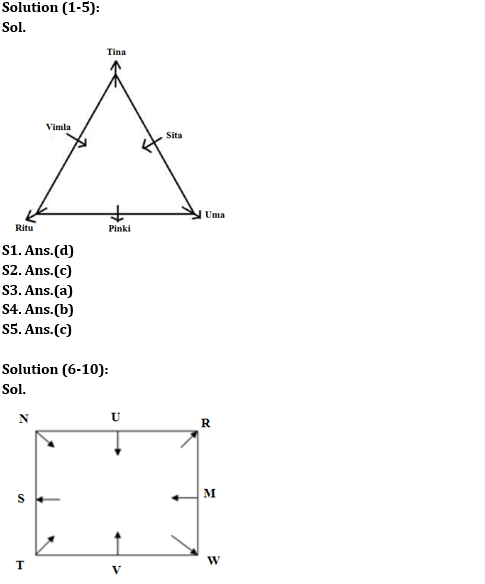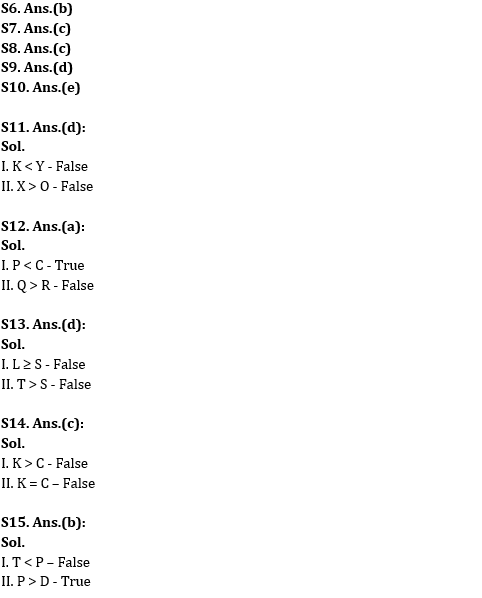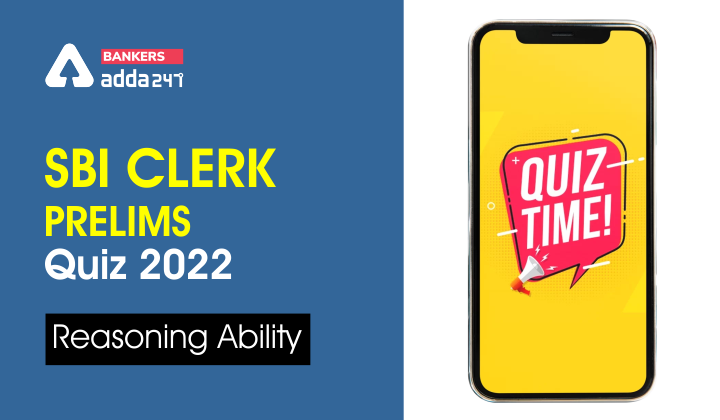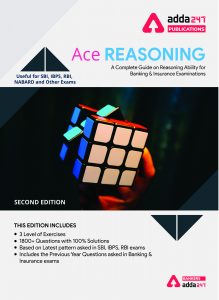Directions (1-5): Read the information carefully and answer the questions below.
There are six persons i.e., Pinki, Vimla, Ritu, Sita, Tina and Uma sitting around an equilateral triangular table. Three persons are sitting at the corner of the table and three persons are sitting at the middle of the sides of the table. Some of them are facing towards the center of the table and the rest are facing outside the table. All the information is not necessarily in the same order.
Tina sits third to the right of Pinki. Tina does not sit in the middle of the sides of the table. Pinki sits second to the left of Sita who faces the opposite direction to Pinki. Ritu is an immediate neighbor of Pinki but not an immediate neighbor of Sita. Vimla sits to the immediate right of Ritu but not to the immediate right of Tina. Uma faces the opposite direction to Vimla. Vimla and Sita face the same direction. Not more than three persons face inside the table.
Reasoning Ability Quiz For SBI Clerk Prelims 2022 CHECK IN HINDI
Q1. How many persons sit between Vimla and Pinki when counted from the left of Vimla?
(a) None
(b) One
(c) Two
(d) Three
(e) None of these
Q2. Who among the following sits fourth to the right of the one who sits to the immediate left of Uma?
(a) Ritu
(b) Tina
(c) Pinki
(d) Vimla
(e) None of these
Q3. Who among the following sits opposite to the one who sits to the immediate right of Pinki?
(a) Sita
(b) Tina
(c) Vimla
(d) Ritu
(e) None of these
Q4. If Ritu and Vimla interchange their positions then who among the following sits third to the right of Vimla?
(a) Tina
(b) Sita
(c) Uma
(d) Pinki
(e) None of these
Q5. Four of the following five are alike in a certain way and hence form a group. Who among the following does not belong to that group?
(a) Tina
(b) Ritu
(c) Vimla
(d) Pinki
(e) Uma
Directions (6-10): Study the following information carefully and answer the questions accordingly.
Eight people are sitting around a square table. Four of them are sitting at the corners and four are sitting at the middle of the sides of the table. Some of them are facing inside and some are facing outside the table. M and N face the opposite direction to R. R sits third to the right of S. T sits third to the right of U. V sits immediate right of W, who faces outside. N sits second to the left of R. S sits immediate left of T but not at the corner. U sits opposite to V, who faces the opposite direction to S.
Q6. How many of them are facing inside?
(a) Two
(b) Five
(c) One
(d) Three
(e) None of these
Q7. Who is sitting immediate right of N?
(a) T
(b) W
(c) S
(d) U
(e) None of these
Q8. How many people sit between R and T?
(a) Five
(b) Four
(c) Three
(d) One
(e) None
Q9. Who among the following sits at the corner?
(a) T, W, R, U
(b) S, V, T, W
(c) N, T, M, U
(d) R, N, W, T
(e) None of these
Q10. Four from the following are similar in a certain way and forms a group. Find out the one, who does not belong to that group.
(a) M
(b) T
(c) N
(d) U
(e) R
Directions (11-15): In the following questions assuming the given statement to be true, find which of the conclusion(s) among given conclusions is/are definitely true and then give your answers accordingly.
Q11. Statements: O < Y, M ≤ U ≤ J ≥ O, X < Q ≤ M ≥ C ≥ K
Conclusions:
I. K < Y
II. X > O
(a) Only conclusion I is true
(b) Only conclusion II is true
(c) Either conclusion I or II is true
(d) Neither conclusion I nor II is true
(e) Both conclusions I and II are true
Q12. Statements: P < E ≤ B < Q, R > B ≤ C < H
Conclusions:
I. P < C
II. Q > R
(a) Only conclusion I is true
(b) Only conclusion II is true
(c) Either conclusion I or II is true
(d) Neither conclusion I nor II is true
(e) Both conclusions I and II are true
Q13. Statement: M ≤ J, J ≥ S < Y, X < T ≤ M ≥ C ≥ L
Conclusion:
I. L ≥ S
II. T > S
(a) Only conclusion I is true
(b) Only conclusion II is true
(c) Either conclusion I or II is true
(d) Neither conclusion I nor II is true
(e) Both conclusions I and II are true
Q14. Statements: Y = P; N < O > K; C = P; K ≥ P; L > C
Conclusions:
I. K > C
II. K = C
(a) Only conclusion I is true
(b) Only conclusion II is true
(c) Either conclusion I or II is true
(d) Neither conclusion I nor II is true
(e) Both conclusions I and II are true
Q15. Statements: P> G ≥ A > D; Q ≥ C = T; P = Q
Conclusions:
I. T <P
II. P > D
(a) Only conclusion I is true
(b) Only conclusion II is true
(c) Either conclusion I or II is true
(d) Neither conclusion I nor II is true
(e) Both conclusions I and II are true
Solutions







 GA Capsule for SBI Clerk Mains 2025, Dow...
GA Capsule for SBI Clerk Mains 2025, Dow...
 The Hindu Review October 2022: Download ...
The Hindu Review October 2022: Download ...
 IB ACIO 2025 Notification PDF Out for 37...
IB ACIO 2025 Notification PDF Out for 37...


